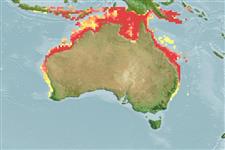>
Scombriformes (Mackerels) >
Scombridae (Mackerels, tunas, bonitos) > Scombrinae
Etymology: Scomberomorus: Latin, scomber = mackerel + Greek, moros = silly, stupid (Ref. 45335).
Environment: milieu / climate zone / depth range / distribution range
Sinh thái học
Biển; Thuộc về nước lợ; Ở đại duơng, biển (Ref. 51243); Mức độ sâu 1 - 100 m (Ref. 6390), usually ? - 30 m (Ref. 6390). Tropical; 7°S - 35°S, 110°E - 157°E (Ref. 168)
Western Pacific: largely confined to inshore coastal waters of southern Papua New Guinea and northern and eastern Australia, from Shark Bay and Onslow, Western Australia to Sydney, New South Wales. This species was confused with Scomberomorus guttatus.
Length at first maturity / Bộ gần gũi / Khối lượng (Trọng lượng) / Age
Maturity: Lm ?, range 48 - ? cm
Max length : 100.0 cm FL con đực/không giới tính; (Ref. 168); common length : 80.0 cm FL con đực/không giới tính; (Ref. 168); Khối lượng cực đại được công bố: 12.2 kg (Ref. 3132)
Các tia vây lưng cứng (tổng cộng): 16 - 18; Các vây lưng mềm (tổng cộng): 17-19; Tia cứng vây hậu môn 0; Tia mềm vây hậu môn: 16 - 20; Động vật có xương sống: 48 - 49. Interpelvic process small and bifid. Lateral line gradually curving down toward caudal peduncle. Intestine with 2 folds and 3 limbs. Swim bladder absent. Body covered with small scales. Membrane of first dorsal fin jet black with large contrasting areas of intense white between the 6th and the last spine. Sides of adults marked with about three indefinite rows of indistinct bronze-gray blotches (absent in 9.5 cm juveniles).
Schooling species which moves into inshore waters, bays and estuaries of Queensland during the southern midwinter and early spring. Often inhabit very turbid coastal waters shallower than 30 m (Ref. 6390). Common length 50 to 80 cm FL (Ref. 12241). Seasonally migratory in the Gulf of Carpentaria and form mixed schools with S. commerson over shallow reefs offshore of Queensland. Trolling lines with lures such as metal spoons and cut bait are used by recreational and commercial fishermen. Mostly marketed fresh (Ref. 9987).
Life cycle and mating behavior
Chín muồi sinh dục | Sự tái sinh sản | Đẻ trứng | Các trứng | Sự sinh sản | Ấu trùng
Collette, B.B. and C.E. Nauen, 1983. FAO Species Catalogue. Vol. 2. Scombrids of the world. An annotated and illustrated catalogue of tunas, mackerels, bonitos and related species known to date. Rome: FAO. FAO Fish. Synop. 125(2):137 p. (Ref. 168)
IUCN Red List Status (Ref. 130435)
Threat to humans
Reports of ciguatera poisoning (Ref. 6390)
Human uses
Các nghề cá: Tính thương mại; cá để chơi: đúng
Các công cụ
Special reports
Download XML
Các nguồn internet
Estimates based on models
Preferred temperature (Ref.
123201): 24.5 - 28.6, mean 27.4 °C (based on 302 cells).
Phylogenetic diversity index (Ref.
82804): PD
50 = 0.5000 [Uniqueness, from 0.5 = low to 2.0 = high].
Bayesian length-weight: a=0.00832 (0.00383 - 0.01808), b=3.03 (2.86 - 3.20), in cm total length, based on LWR estimates for this Genus-body shape (Ref.
93245).
Mức dinh dưỡng (Ref.
69278): 4.5 ±0.8 se; based on diet studies.
Thích nghi nhanh (Ref.
120179): Trung bình, thời gian nhân đôi của chủng quần tối thiểu là 1.4 - 4.4 năm (tm=1-2).
Fishing Vulnerability (Ref.
59153): Low to moderate vulnerability (33 of 100).
Nutrients (Ref.
124155): Calcium = 38.2 [17.5, 147.4] mg/100g; Iron = 0.94 [0.43, 2.31] mg/100g; Protein = 21 [20, 22] %; Omega3 = 0.295 [0.178, 0.499] g/100g; Selenium = 66.7 [23.7, 308.3] μg/100g; VitaminA = 14.9 [2.9, 71.4] μg/100g; Zinc = 0.756 [0.504, 1.192] mg/100g (wet weight);
